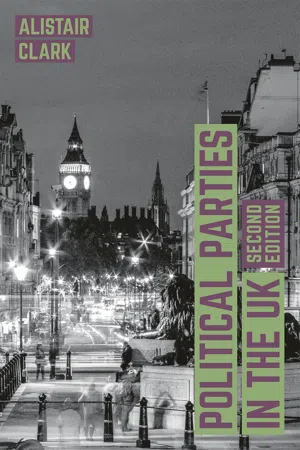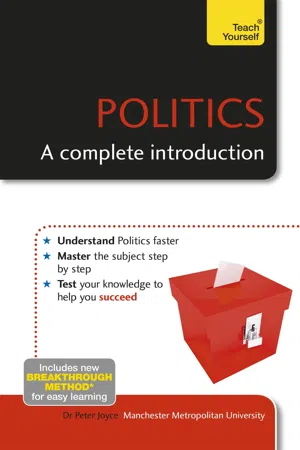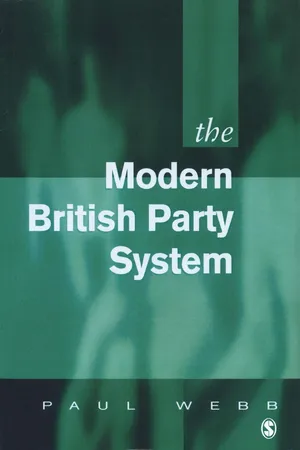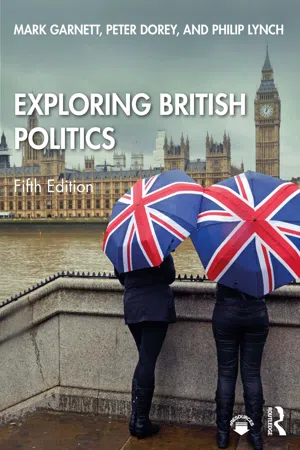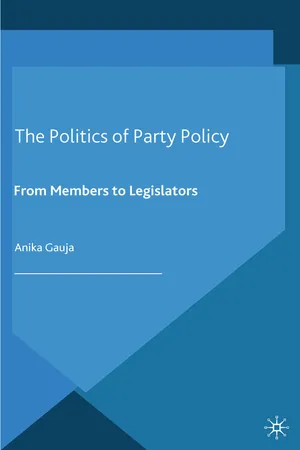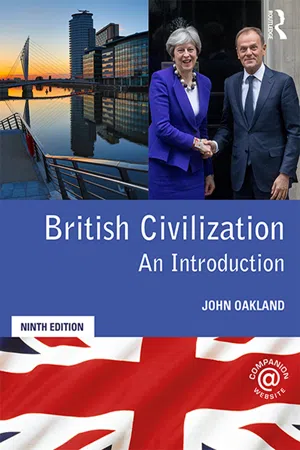Politics & International Relations
UK Political Parties
UK political parties are organizations that represent different political ideologies and compete for power in the British political system. The main parties include the Conservative Party, Labour Party, Liberal Democrats, and Scottish National Party, among others. Each party has its own policies and priorities, and they play a crucial role in shaping the country's governance and policies.
Written by Perlego with AI-assistance
Related key terms
6 Key excerpts on "UK Political Parties"
- eBook - ePub
- Alistair Clark(Author)
- 2018(Publication Date)
- Bloomsbury Academic(Publisher)
2 THE ROLE OF POLITICAL PARTIES IN THE UKAccording to Schattschneider (1942) ‘modern democracy is unthinkable save in terms of political parties’. Yet political parties are also often the source of much disillusion among electors. In recent years parties have been said to be in decline in a number of ways, whether in terms of their membership, or in their ability to motivate electors to turn out to vote for them. Against this backdrop, this chapter assesses the current literature on British parties to ask two key questions: what is the role of political parties in the modern UK; and to what extent are parties successfully fulfilling their democratic functions? The first section begins by setting out various definitions of political parties and highlighting their functions in democracies. The second section addresses itself to the question: to what extent are the UK’s parties successfully fulfilling these roles? British parties are argued to be fulfilling these functions to varying degrees. While they continue to simplify the electoral choices available to voters, they have been decreasingly able to command the loyalty of voters. Nevertheless, through their position in organising both government and opposition in the House of Commons and the devolved assemblies, parties play a crucial, if not always necessarily central, role in providing political accountability in the UK. Arguably political parties have become decreasingly rooted in the communities they aspire to represent, thereby leaving governing and electioneering at the heart of what parties currently do in the UK today.Defining Political PartiesWhat is a political party? Definitions of parties can be found from eighteenth-century philosophers such as David Hume and Edmund Burke (van Biezen and Saward, 2008: p.23), through to the more recent work of specialists such as Sartori (2005 [1976]). Consequently, there are many competing definitions of what parties are and what they do. Rather than try to resolve this long-standing debate with one definition, it is useful to have a conception of the various different understandings of parties that scholars have set out and the different elements that they each emphasise. Sartori’s (2005 [1976]: p.57) minimal definition suggests that ‘a party is any political group that presents at elections, and is capable of placing through elections, candidates for public office’. Panebianco (1988: p.6) similarly points to electoral competition as an activity that distinguishes parties from the goals of other political organisations such as pressure groups. While compellingly simple, there are two difficulties with these definitions. Neither considers what parties do if they are successful in being elected to office, and in recent years single-issue pressure groups have increasingly sought influence by contesting elections, thereby blurring the distinction between them and parties. Ware (1996: p.5) attempts to resolve these difficulties by proposing that ‘[a] political party is an institution that a) seeks influence in a state, often by attempting to occupy positions in government, and b) usually consists of more than a single interest in society and so to some degree attempts to “aggregate interests”’. However, this renders the electoral aspect an implicit element of his definition, something that many observers would consider crucial. An understanding and combination of each of these three approaches to defining parties is therefore a necessary initial condition for understanding what parties are and what they do. - Peter Joyce(Author)
- 2015(Publication Date)
- Teach Yourself(Publisher)
5 Political parties and party systemsParties and party systems GENERAL CHARACTERISTICSPolitical parties are especially prominent at election times. Their key purpose is to determine the composition of government and the policies that it carries out. To achieve this objective a party may operate independently or it can co-operate with other political parties by participating in coalition governments. In this chapter we will consider the functions served by political parties, the factors influencing their development, and the contemporary problems facing political parties.
A political party is a formally organized organization that seeks to secure power and exercise control over government. This may be at national, state, regional or local level.Key idea (1) It has been argued that ‘Most democratic parties seek to control the executive function of government … and in democracies they organise themselves to win elections and form administrations (or at least participate in their formation) in order to control the machinery of government’ (Ingle, 2008: 2).Ingle, S. (2008) The British Party System: An Introduction. London: Routledge, 4th ed. revised.Parties seek political power. A party possesses a formal structure that involves national leadership and local organization. The main role of the latter is to contest elections and recruit party members. This organization is permanent, although it may be most active at election times. The relationship between a party’s leaders and its membership varies quite considerably, especially the extent to which a party’s leaders can be held accountable for their actions by its rank-and-file supporters. Policy making is frequently the preserve of the party’s national leadership, which may also possess some degree of control over the selection of candidates for public office.- eBook - ePub
- Paul Webb(Author)
- 2000(Publication Date)
- SAGE Publications Ltd(Publisher)
9
PARTIES AND THE POLITICAL SYSTEM
CONTENTS
Popular dissatisfaction with British political parties The systemic functionality of political parties in BritainGovernance and political recruitmentRepresentationPolitical communicationConclusion NotesPolitical participationWe have now considered at length the variety and extent of changes affecting British party politics since 1970. Essentially these entail both programmatic and organizational responses to change in the electoral market, which in turn derives from factors such as the growing heterogeneity of British society. Before concluding our study of party politics in the UK, it is essential that we reflect on the implications of these patterns of change for the broader political system: in short, how well does the party system serve the political system as a whole?The value of parties to the political system is closely bound up with problems of party legitimacy and ‘decline’. A number of critics have claimed that political parties are in a state of decline precisely because they (the parties) fail to fulfil certain requirements which the wider political system makes of them. Those on the left have been particularly prone to see evidence of party decline in this sense. For instance, Martin Jacques has contrasted the erosion of party-society links with the burgeoning non-partisan associative life of the country. In this context, he argued that the established model of representative politics which focuses on the parties at Westminster constitutes something of an impasse for democracy and it needed to be supplemented by the development of new forms of political participation (Jacques 1993). In similar vein Geoff Mulgan, former director of the independent think-tank Demos and a policy advisor to prime minister Tony Blair, once asserted that ‘it is hard to see the secular decline of the party reversing’ (Mulgan 1994a: 18). According to Mulgan, this decline is associated with a gap between the ethos and practice of democracy, and parties in parliament, he insists, are the culprits in much of this, stuck as they are in the nineteenth century – ‘centralized, pyramidal, national with strictly defined rules of authority and sovereignty’ (op. cit.: 16; see also Mulgan, 1994b). - eBook - ePub
- Mark Garnett, Peter Dorey, Philip Lynch(Authors)
- 2020(Publication Date)
- Routledge(Publisher)
Publius: The Journal of Federalism , Vol. 36, No. 1 (2006), pp. 115–34, is a more detailed study.Websites
- The official websites of British political parties contain details on their election results and policies. Richard Kimber’s politics ‘gateway’ (www.politicsresources.net ) provides valuable links. The websites of the main parties in the UK are:
- Conservative Party: www.conservatives.com
- Labour Party: www.labour.org.uk
- Liberal Democrats: www.libdems.org.uk
- Plaid Cymru: www.plaidcymru.org
- Scottish National Party: www.snp.org
- Greens: www.greenparty.org.uk
- UK Independence Party: www.ukip.org
- Brexit Party: www.thebrexitparty.org/
- Democratic Unionist Party: www.dup.org.uk
- Ulster Unionist Party: www.uup.org
- Sinn Fein: www.sinnfein.ie
- Social Democratic and Labour Party: www.sdlp.ie
Passage contains an image
Chapter 15
Party organisationLearning outcomes
After reading this chapter, you will:- be able to explore different perspectives on the role of UK parties;
- understand the organisation of the main political parties in the UK; and
- be able to evaluate the strengths and weaknesses of the rules governing party finance.
Introduction
Most commentators accept that political parties are an inevitable feature of liberal democracy. Yet in the UK today, parties are often accused of bringing democracy into disrepute. Critics claim that they are more interested in ‘playing party politics’ than in addressing national priorities in a constructive fashion.It is usually argued that disillusion with political parties is a major factor in the decline in voter turnout in general elections. Certainly this trend, culminating in a figure of below 60 per cent in 2001, coincided with a sharp fall in membership of the parties themselves. In defence of UK parties, it can be argued that their plight merely reflects a more general tendency of people to disengage from traditional forms of voluntary activity. In particular, citizens are more inclined to throw their energies into single-issue pressure groups, which lobby MPs instead of putting themselves to the trouble of securing their own elected representatives (see Chapter 19 - eBook - ePub
The Politics of Party Policy
From Members to Legislators
- A. Gauja(Author)
- 2015(Publication Date)
- Palgrave Macmillan(Publisher)
Following on from participation, the second element in the linkage chain is representation, which parties perform in two ways. First, it is the intended product of electoral competition as voters show their support for particular parties by electing their preferred candidate for public office. To the extent that parties hold an effective monopoly over candidate nomination (most voters will vote for a party rather than a specific candidate), the performance of the function in this sense is not really in doubt. Nonetheless, societal representation also occurs within the legislative arena in the course of drafting, deliberating and voting on parliamentary bills. Evaluating the extent to which groups and individuals are able to influence a party’s internal policy and decision-making processes is a good indicator of the responsiveness and in turn representativeness of a political party, assuming one crucial factor: that the political direction and policy determined by the party is actually translated into legislative action. It is in this context that the role of the party in public office is paramount: what good is party policy that has been formulated with the maximum participation of party members and/or citizens if it is not applied within the parliamentary arena? This aspect of the function is crucial as it is the final phase parties play in linking society and the state, but it is often overlooked in the literature on party organisation (see Heidar and Koole, 2000).Democratic linkage and party government
In what Judge (1999, p. 71) refers to as an ‘idealised view of responsible government’, membership participation should be translated into policy outcomes in the following sequence: first, a party formulates a manifesto and/or policies to present to voters at a general election with the maximum possible citizen/membership participation; second, voters choose between parties on the basis of their manifestos and policies; and third, parties seek to translate their policies and platforms into legislative outcomes once they have gained parliamentary representation. This sequence is similar to conceptions of the broader role of parties in a representative democracy, particularly the way in which elections connect voters to government: - eBook - ePub
British Civilization
An Introduction
- John Oakland(Author)
- 2019(Publication Date)
- Routledge(Publisher)
They are relatively strong in south-west England, Wales and Scotland and increased their MPs at the 2001 and 2005 general elections to become the biggest third party in Parliament since 1929. But they lack a clearly defined identity and policies that are recognized by the electorate. The Lib Dems have won some dramatic by-elections and had considerable success in local government elections. But they have not made a large breakthrough into the Commons or the EU Parliament, where they did badly in the 2014 election. They have also faced the threat from the United Kingdom Independence Party (UKIP) and lost support for their central policies. Electoral reform to a form of PR might increase their number of MPs. While their performance in the 2010–15 coalition government was criticized, they tasted power and worked efficiently within the political restraints. However, they did badly in the 2015 General Election and lost many MPs, as more supporters and members objected to their policies and left the party.Smaller parties are also represented in the House of Commons, such as the Scottish National Party; Plaid Cymru (the Welsh National Party); the Ulster Unionists and the Democratic Unionist Party (Protestant Northern Irish parties); the Social Democratic and Labour Party (moderate Nationalist, largely Roman Catholic Northern Irish party); and Sinn Féin (Republican Northern Irish party). Other small parties, such as the Greens, UKIP and fringe groups (like the Raving Monster Loony Party), may also contest general elections. A candidate who fails to gain a certain number of votes in the election loses their deposit (the sum of money paid when parties register for elections).Social class and family tradition used to be important factors in British voting behaviour. But these have now been largely replaced by property- and share-owning, job status, wages, immigration and other considerations, including apathy among voters. A more volatile and abusive political situation exists as voters switch between Labour, Conservatives, Liberal Democrats, UKIP and smaller parties and employ ‘tactical voting’ in some constituencies to prevent specific opposition party candidates from being elected. General elections are often won by a party that captures ‘marginal constituencies’ where a slight vote swing can change party representation and ‘floating voters’ who are not committed to a specific party can influence the result. The changing character and reality of the electorate have forced political parties to adopt policies that are more representative of people’s wishes and needs, such as jobs, immigration and the European Union. The traditional ideological divides are no longer so obvious, important or relevant, although the 2017 General Election campaign returned to some Left–Right battles.
Index pages curate the most relevant extracts from our library of academic textbooks. They’ve been created using an in-house natural language model (NLM), each adding context and meaning to key research topics.
